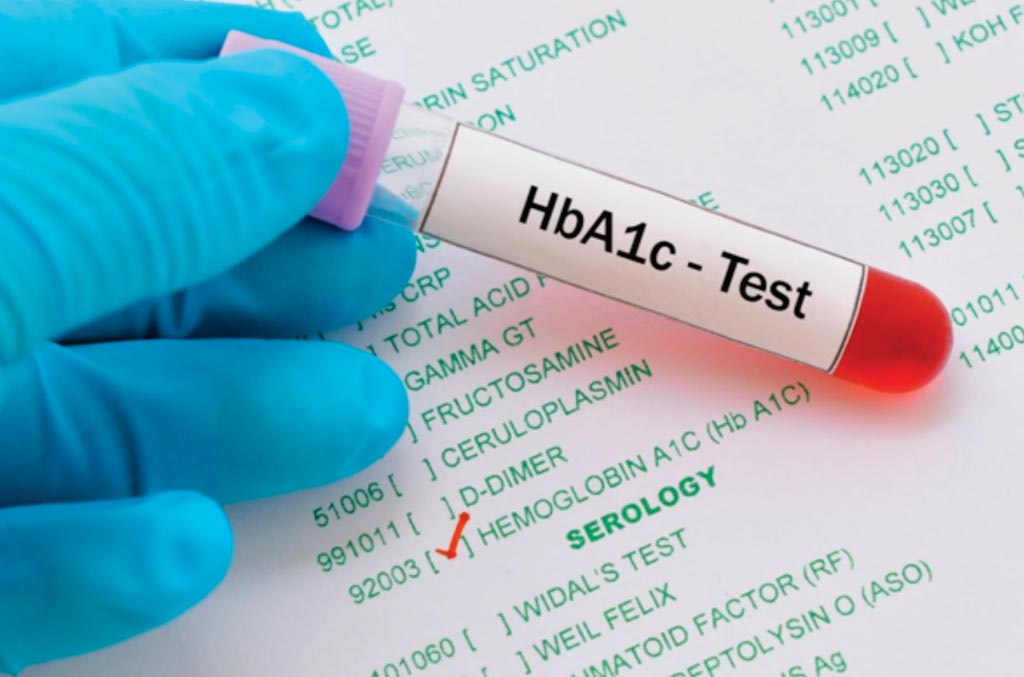Blood Sugar Levels Affect Risks in Type 1 Diabetes
By LabMedica International staff writers
Posted on 12 Sep 2019
Type 1 diabetes is the predominant form of diabetes diagnosed in childhood and is characterized by increased blood glucose levels resulting from insulin deficiency. Intensive treatment with better glycemic control has been shown to reduce the risk of retinopathy and nephropathy, with a strong association between glycated hemoglobin (HbA1c) level and diabetes complications.Posted on 12 Sep 2019
The evidence for HbA1c levels and diabetes complications is interpreted differently by organizations. Reaching lower HbA1c levels requires greater effort from people with diabetes and their families and can be associated with more stress and possibly an increased risk of hypoglycemia, which in itself can be burdensome and lead to unconsciousness.

Image: A major new study on the association between blood glucose levels, including HbA1c, and risks of organ impairment in people with type 1 diabetes can make a vital contribution to diabetes care (Photo courtesy of HealthEngine).
Scientists from the University of Gothenburg (Gothenburg, Sweden) and their colleagues included in a study included children and adults with a diagnosis of diabetes for five or less years when first recorded in the registries. Endpoints of retinopathy were classified as any retinopathy, preproliferative diabetic retinopathy or worse, and proliferative diabetic retinopathy. Any retinopathy included any signs of retinopathy.
Microalbuminuria was defined as two positive test results from three samples taken within one year, with an albumin:creatinine ratio of 3-30 mg/mmol or urinary albumin of 20-200 µg/min (20-300 mg/L), and macroalbuminuria as an albumin:creatinine ratio >30 mg/mmol or urinary albumin >200 µg/min (>300 mg/L). Laboratory methods at participating care units for analyzing HbA1c level and albuminuria are regularly checked with central reference samples of HbA1c and albuminuria to ensure high accuracy. The team evaluated HbA1c as a categorical variable (<6.5% (<48 mmol/mol), 6.5-6.9 (48-52 mmol/mol), 7.0-7.4% (53-57 mmol/mol), 7.5-8.6% (58-70 mmol/mol), and >8.6% (>70 mmol/mol) and estimated risk of complications in relation to HbA1c level as a continuous variable for each 1% (10 mmol/mol).
The scientists reported that the mean age of participants was 14.7 years (43.4% female), mean duration of diabetes was 1.3 years, and mean HbA1c level was 8.0% (63.4 mmol/mol). Compared with HbA1c levels 6.5-6.9%, HbA1c levels 7.0-7.4% (53-57 mmol/mol) were associated with an increased risk of any retinopathy (1.31, 1.05 to 1.64) and microalbuminuria (1.55, 1.03 to 2.32). In Sweden, the target HbA1c value in people with type 1 diabetes is 52 mmol/mol or below, and 47 or lower in children. Elsewhere in the world, the guidelines range from 48 to 58 mmol/mol, and are often higher in children than in adults.
The authors concluded that the risk of retinopathy and nephropathy did not differ at HbA1c levels <6.5% but increased for severe hypoglycemia compared with HbA1c levels 6.5-6.9%. The risk for severe complications mainly occurred at HbA1c levels >8.6%, but for milder complications was increased at HbA1c levels >7.0%.
Marcus Lind, MD, PhD, a Professor of Diabetology and first author of the study, said, “We were unable to see that fewer instances of organ damage occurred at these lower levels. As for loss of consciousness and cramp, which are unusual, low blood glucose caused a 30% rise in risk. Patients with low HbA1c need to make sure they do not have excessively low glucose levels, fluctuations or efforts in managing their diabetes.” The study was published on August 28, 2019, in the journal BMJ.
Related Links:
University of Gothenburg














